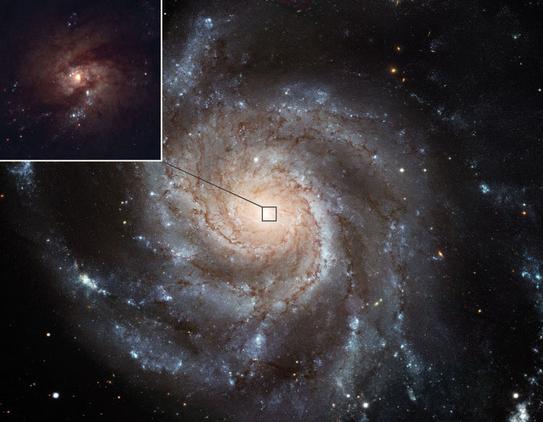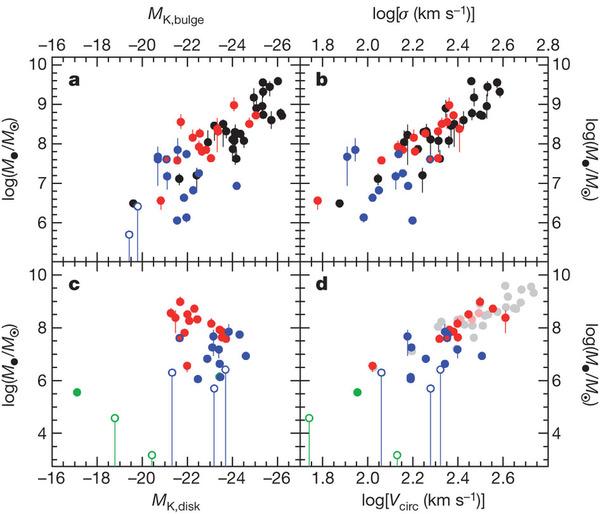“A large galaxy usually has a central, compact massive object, termed a relativistic black hole for want of a better idea of what it is, that can produce great bursts of energy. When the black hole is surrounded by a cloud of old stars — the ‘bulge’ of the host galaxy — its mass is a few per cent of the mass of the bulge. This relationship, observed for black-hole masses ranging from about 1 million to 1,000 million solar masses, suggests that black holes and bulges evolved together. Other large, spiral-shaped galaxies have black holes of respectable mass (1 million to 100 million solar masses) and no perceptible bulge. How these bulgeless, or pure-disk, spirals and their black holes formed?” P. James E. Peebles (Princeton University, Princeton, NJ, US), “Astrophysics: How galaxies got their black holes,” Nature 469: 305–306, 20 January 2011,News & Views on John Kormendy, R. Bender & M. E. Cornell, “Supermassive black holes do not correlate with galaxy disks or pseudobulges,” Nature 469: 374–376, 20 January 2011, and John Kormendy & Ralf Bender, “Supermassive black holes do not correlate with dark matter haloes of galaxies,” Nature 469: 377–380, 20 January 2011.
“Most of the mass in galaxies does not exist in the form of stars but in a halo of dark matter (matter different from the hydrogen and heavier elements of which we and the stars are made). There is a substantial literature on the elegant idea that dark matter controls the size of the central black hole, but Kormendy and Bender show that this cannot be so. The nearby bulgeless spiral galaxy M101 (figure above) illustrates the situation: if M101 has a central black hole, its mass must be tiny relative to that of the black holes of other spirals with similar dark-matter haloes. There are roughly equal numbers of nearby large galaxies with and without bulges. For example, the galaxy next to ours, M31, has a prominent bulge and a black-hole mass close to 100 million solar masses, whereas our Galaxy, which has a similar dark-matter halo, is bulgeless, and the black-hole mass is only a few per cent of that in M31.
“Bulges and their black holes seem to be a natural consequence of structure formation in the hot Big Bang theory of the expanding Universe. According to this theory, galaxies grew by gravitational assembly of matter into clumps that gathered into larger clumps, and so on to galaxies. In galaxies with bulges, including ellipticals, which have bulges and no disks, the mass of the central black hole correlates not only with the mass of the bulge, but also, as Kormendy, Bender and Cornell note, with the average spread of velocities of the bulge stars (see Fig. a, above). The plausible explanation is that the growth of bulge and black hole may have controlled each other. Moreover, the mass distribution in a spiral galaxy varies smoothly from its outer, dark-matter-dominated parts to its inner parts, where the mass in stars is important. The dark matter seems to have had a strong influence on the formation of the spiral galaxy’s disk of gas, stars and dust — but not on the formation of the central black hole.”
courtesy by http://francisworldinsideout.wordpress.com/2011/01/19/peebles-in-nature-how-galaxies-got-their-black-holes/


No comments:
Post a Comment